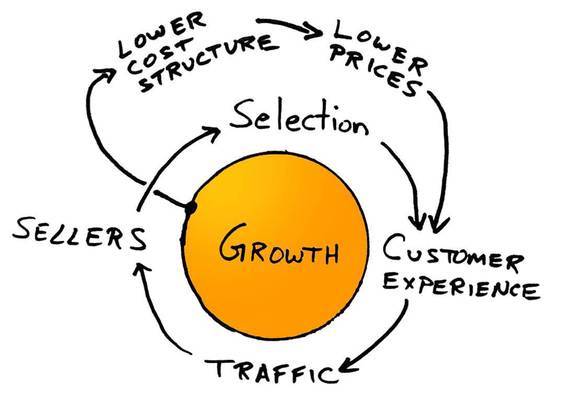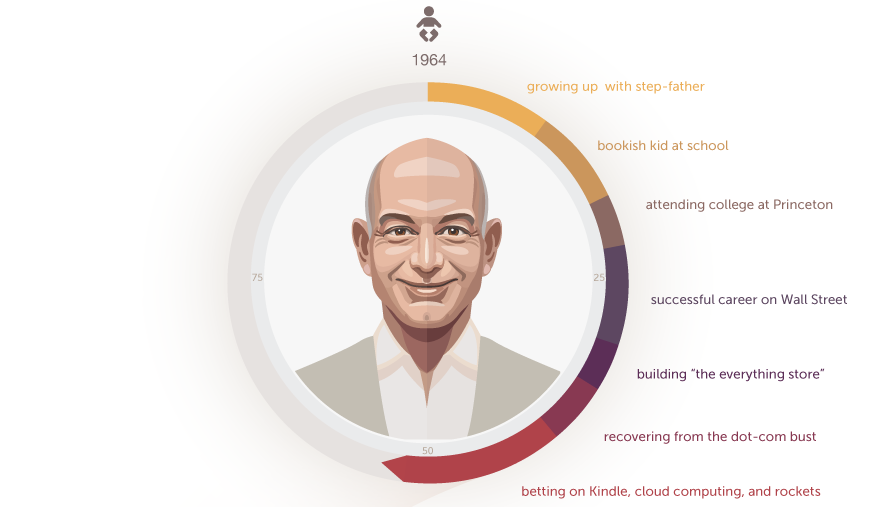Technology
How Jeff Bezos Built his Amazon Empire
On Friday afternoon, Amazon CEO Jeff Bezos briefly passed Warren Buffett to become the world’s third-richest person. Amazon shares have been up 54% since February, propping up his net worth to an impressive $65 billion.
How Jeff Bezos Built his Amazon Empire
Today’s infographic is from Funders and Founders, and it visualizes the career of Jeff Bezos in creating his “Everything Store”.

Image courtesy of: Funders and Founders
While Bezos was ahead of Buffett by about $300 million on Friday afternoon, Amazon’s share price later dipped at the close to erase the lead.
This likely isn’t the last time that a rising Bezos will be biting at the heels of Bill Gates ($88.7B), Amancio Ortega ($73.5B), and Warren Buffett ($65.1B).
How Did Bezos Do It?
“We are willing to be misunderstood for long periods of time.” – Jeff Bezos
Perhaps the most enthralling element of the Jeff Bezos story is his resolute commitment to executing a long-term vision, all while the rest of the world could not comprehend it.
The company ran 20 years without showing signs of significant profit, and it was regularly criticized in the media. Pundits saw Amazon as a growing online book store that couldn’t make money. They didn’t get the bigger picture.
And while the world debated Amazon’s aggressive expansion and polarizing nature, Bezos and his team stayed focused on execution. Even if people didn’t see the vision for the “everything store”, it didn’t mean that Amazon couldn’t build it.
They were willing to be misunderstood for a long time in order to follow the vision – one that was written down by Bezos in a famous napkin sketch:

Image courtesy of: Amazon
Note that in this sketch, which is now over 15 years old, that there is no “take profits” offshoot. It’s a closed loop that uses free cash flow to reinvest back into the established business plan of providing low cost leadership.
And now that Amazon has executed on this plan successfully, it is finally time for profits. That’s why the company had a record quarter earlier this year, and why analysts expect Q2 to be just as impressive.
Watch out Warren, because Bezos isn’t done yet.
Technology
Ranked: Semiconductor Companies by Industry Revenue Share
Nvidia is coming for Intel’s crown. Samsung is losing ground. AI is transforming the space. We break down revenue for semiconductor companies.
Semiconductor Companies by Industry Revenue Share
This was originally posted on our Voronoi app. Download the app for free on Apple or Android and discover incredible data-driven charts from a variety of trusted sources.
Did you know that some computer chips are now retailing for the price of a new BMW?
As computers invade nearly every sphere of life, so too have the chips that power them, raising the revenues of the businesses dedicated to designing them.
But how did various chipmakers measure against each other last year?
We rank the biggest semiconductor companies by their percentage share of the industry’s revenues in 2023, using data from Omdia research.
Which Chip Company Made the Most Money in 2023?
Market leader and industry-defining veteran Intel still holds the crown for the most revenue in the sector, crossing $50 billion in 2023, or 10% of the broader industry’s topline.
All is not well at Intel, however, with the company’s stock price down over 20% year-to-date after it revealed billion-dollar losses in its foundry business.
| Rank | Company | 2023 Revenue | % of Industry Revenue |
|---|---|---|---|
| 1 | Intel | $51B | 9.4% |
| 2 | NVIDIA | $49B | 9.0% |
| 3 | Samsung Electronics | $44B | 8.1% |
| 4 | Qualcomm | $31B | 5.7% |
| 5 | Broadcom | $28B | 5.2% |
| 6 | SK Hynix | $24B | 4.4% |
| 7 | AMD | $22B | 4.1% |
| 8 | Apple | $19B | 3.4% |
| 9 | Infineon Tech | $17B | 3.2% |
| 10 | STMicroelectronics | $17B | 3.2% |
| 11 | Texas Instruments | $17B | 3.1% |
| 12 | Micron Technology | $16B | 2.9% |
| 13 | MediaTek | $14B | 2.6% |
| 14 | NXP | $13B | 2.4% |
| 15 | Analog Devices | $12B | 2.2% |
| 16 | Renesas Electronics Corporation | $11B | 1.9% |
| 17 | Sony Semiconductor Solutions Corporation | $10B | 1.9% |
| 18 | Microchip Technology | $8B | 1.5% |
| 19 | Onsemi | $8B | 1.4% |
| 20 | KIOXIA Corporation | $7B | 1.3% |
| N/A | Others | $126B | 23.2% |
| N/A | Total | $545B | 100% |
Note: Figures are rounded. Totals and percentages may not sum to 100.
Meanwhile, Nvidia is very close to overtaking Intel, after declaring $49 billion of topline revenue for 2023. This is more than double its 2022 revenue ($21 billion), increasing its share of industry revenues to 9%.
Nvidia’s meteoric rise has gotten a huge thumbs-up from investors. It became a trillion dollar stock last year, and broke the single-day gain record for market capitalization this year.
Other chipmakers haven’t been as successful. Out of the top 20 semiconductor companies by revenue, 12 did not match their 2022 revenues, including big names like Intel, Samsung, and AMD.
The Many Different Types of Chipmakers
All of these companies may belong to the same industry, but they don’t focus on the same niche.
According to Investopedia, there are four major types of chips, depending on their functionality: microprocessors, memory chips, standard chips, and complex systems on a chip.
Nvidia’s core business was once GPUs for computers (graphics processing units), but in recent years this has drastically shifted towards microprocessors for analytics and AI.
These specialized chips seem to be where the majority of growth is occurring within the sector. For example, companies that are largely in the memory segment—Samsung, SK Hynix, and Micron Technology—saw peak revenues in the mid-2010s.
-

 Real Estate2 weeks ago
Real Estate2 weeks agoVisualizing America’s Shortage of Affordable Homes
-

 Technology1 week ago
Technology1 week agoRanked: Semiconductor Companies by Industry Revenue Share
-

 Money1 week ago
Money1 week agoWhich States Have the Highest Minimum Wage in America?
-

 Real Estate1 week ago
Real Estate1 week agoRanked: The Most Valuable Housing Markets in America
-

 Business2 weeks ago
Business2 weeks agoCharted: Big Four Market Share by S&P 500 Audits
-

 AI2 weeks ago
AI2 weeks agoThe Stock Performance of U.S. Chipmakers So Far in 2024
-

 Misc2 weeks ago
Misc2 weeks agoAlmost Every EV Stock is Down After Q1 2024
-

 Money2 weeks ago
Money2 weeks agoWhere Does One U.S. Tax Dollar Go?














